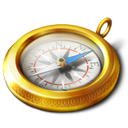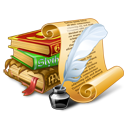Whats Hot!
The Purifiers
September 05, 2015
![]() In the Millennium of Purification, a group of Elves and Dwarves join forces to purge the world of the dark magicks they themselves once helped unleash. Is there a chance to make up for their sins of the past and restore order to the world? Find out in the serial fan fic: The Purifiers.
In the Millennium of Purification, a group of Elves and Dwarves join forces to purge the world of the dark magicks they themselves once helped unleash. Is there a chance to make up for their sins of the past and restore order to the world? Find out in the serial fan fic: The Purifiers.
Most Useful
Reference Scrolls
May 05, 2015
![]() Some of the most viewed pages on this site are the O.C.C. List, Race List, and Skills List, all for Palladium Fantasy. This includes material from the various books, along with which book they're located in. This is an invaluable resource for new and experienced gamers alike.
Some of the most viewed pages on this site are the O.C.C. List, Race List, and Skills List, all for Palladium Fantasy. This includes material from the various books, along with which book they're located in. This is an invaluable resource for new and experienced gamers alike.
Need Help?
Checkout the Sitemap
September 05, 2015
![]() Whether you're new to the site or a long time fan but can't find an old favorite, feel free to check out the Sitemap. This is a list of all the pages on this site to help navigate you through your trip into the fantasy.
Whether you're new to the site or a long time fan but can't find an old favorite, feel free to check out the Sitemap. This is a list of all the pages on this site to help navigate you through your trip into the fantasy.
Cultures of the Palladium World
Anthropology is a skill written in nearly every Palladium game line, but in my experience it's a skill that tends to go overlooked. People who do seek such a skill tend to make a new one such as Lore: Culture & Customs (Fantasy Book 11: Eastern Territory) or several other "lore" skills (included in Rifts and other settings). As a result, I wanted to help reinforce the type of knowledge that the anthropology skill grants.
What makes an Elf more than a human with pointed ears and a Gnome more than a short human? Is it just a few natural abilities like Nightvision or a higher P.P.E.? I'd like to think it's something more. So the more I got into the Palladium Fantasy setting the more I wanted to set these races apart. I started taking down notes for how I wanted these races to act. Then I continued to build and expand upon it until those notes became what you see before you today. As a G.M. this was a valuable tool.
But, as a player, such a write-up could be limiting. After all, most players don't want to be told they have to play their character a certain way. So when I wrote this, I tried to reinforce the fact that not everyone will follow these same concepts. These are here to provide an idea and a guideline. Not only can it be useful for a G.M., but I've seen players who ask for suggestions when playing an Elf for the first time, or who have trouble thinking of anything other than a human mindset. My hope is that this will inspire ideas for those who enjoy such things.
Note: Not all the races included here were written by me. Also included are references where to find some information on certain races and the book it can be found (as well as the writer if the source is a Rifter and not official Palladium Book material).
Surface Dwellers
Human Cultures: See specific regional Palladium sourcebook for the human kingdoms. Also, real life society and history can be good inspiration for creating human culture notes for those not mentioned in the books.
Elven Culture: Elves are a common race within human settlements and a popular player character choice. This is a perfect chance to learn more about their language, naming schemes, marriages and funerals, fighting preferences, ruling structure, various formalities, and more.
Orc, Goblin, and Hob-Goblin (collectively, along with Kobold) Culture: See Rifter 16 for details (section titled Young, Dumb, and Ugly; page 24, by Mark Hall).
Subterranean Races
Dwarven Culture: A common human ally and popular fantasy race. Get to know more about their language, naming schemes, views on magic, sworn oaths, fighting preferences, ruling structure, whether Dwarven females really have beards or not, and more.
Gnome Culture: Tiny and easy-going, what more could we possibly need to know? More than you may think as we delve into more about their names, views on love, general philosophies on life, and a few traits unique just to them.
Troglodyte Culture: I believe the description in the main book describes their culture (or lack thereof) well enough for my tastes. See Rifter 34 for details (section titled Troglodytes, page 19, by Mark Hall).
The Giants
Wolfen Culture: See Adventures in the Northern Wilderness or Wolfen Empire sourcebooks for details. Also, see Rifter 13 for details on the extinct Algor Range Huntsman tribe (see section titled The Thirteenth Tribe; page 45, by Richard Thomasssen).
Ogre Culture: Whether a player character or a NPC, learning more about these small giants can be invaluable. Learn more about their language, parenting, hunting, and a glimpse at possible origins.
Troll Culture: Giant, loners, and fearsome opponents. However they have a language, views on combat that don't always end in killing, plus lairs and plenty of treasure.
Rahu-Men Culture: See Rifter 5 for details (section titled The Rahu-Man; page 31, by Peter Finin). This information is mainly intended for Heroes Unlimited, Ninjas and Superspies, Rifts, and others, but it can still be a useful source for those desiring to understand more of these giants.
Exotic Monsters
Gosai Culture: Gosai are the silent assassins who strike from the shadows, favoring precision and accuracy above all else. They seem exotic and spooky, until one truly gets to know them. Note: Included are The Homeworld, Language, Emotions and Revenge, and Duels of Honor. Still being worked on are Children and Aging, Preferred Weapons, Ancient Rivalries, Magic, and more.
Lizard Men Culture: See Rifter 26 for details (section titled Unknown Depths; page 40, by Andrew Rusling).
Quorian Culture: See Rifter 55 for details (section titled Home Away from Home; page 18, by Travis S. Guerrero). This issue and article also includes details on the Quorian Riftlord, fleshed out and designed as a playable class.
Creatures of Magic and Supernatural Beings
Changeling Culture: Shapeshifters persecuted across the world and hunted to near extinction. Decide if they're monsters or just misunderstood as we explore more about their biology, behaviour, and history. Also see Rifter 10 for details (section titled The Changeling Metamorph; page 24, by Mark Hall).
Gargoyle Culture: See Rifts World Book Five: Triax and the NGR for details.
Brodkil Culture: See Rifter 46 for details (section titled Rebel Waltz; page 39, by Mark Hall).
Dragon Culture: A popular race with several different species. Learn more about their language, their role throughout history, extinct species, and more about their nature, but how much of this information can truly be trusted? Also see Palladium Fantasy RPG Sourcebook Dragons and Gods for additional, and official as opposed to Rifter material, information. Also, see Rifter 12 for biology of a dragon (see section entitled Blue Print of a Dragon; page 73, by John Courtenay Shera) and Rifter 46 for how dragons interact with each other in a society (see section entitled Dragons in Society; page 37, by J. Woodman). Both Rifter articles are designed for Rifts, but can be a useful source for ideas and a new look at dragons.






